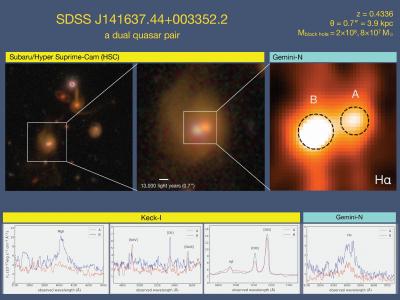Maunakea observatories discover three pairs of merging supermassive black holes

Credit: Silverman et al.
Maunakea, Hawaii – A cosmic dance between two merging galaxies, each one containing a supermassive black hole that’s rapidly feeding on so much material it creates a phenomenon known as a quasar, is a rare find.
Astronomers have discovered several pairs of such merging galaxies, or luminous “dual” quasars, using three Maunakea Observatories in Hawaii – Subaru Telescope, W. M. Keck Observatory, and Gemini Observatory.
These dual quasars are so rare, a research team led by the Kavli Institute for the Physics and Mathematics of the Universe at the University of Tokyo estimates only 0.3% of all known quasars have two supermassive black holes that are on a collision course with each other.
The study is published in the August 26, 2020 issue of the Astrophysical Journal.
“In spite of their rarity, they represent an important stage in the evolution of galaxies, where the central giant is awakened, gaining mass, and potentially impacting the growth of its host galaxy,” said Shenli Tang, a graduate student at the University of Tokyo and co-author of the study.
Quasars are one of the most luminous, energetic objects known in the universe, powered by supermassive black holes that are millions to billions times more massive than our Sun. As material swirls around a black hole at the center of a galaxy, it is heated to high temperatures, releasing so much light that the quasar can outshine its host galaxy.
This makes a merging pair of galaxies with quasar activity hard to detect; it is difficult to separate the light from the two quasars because they are in such close proximity to each other. Also, observing a wide enough area of the sky to catch these rare events in sufficient numbers is a challenge.
To overcome these obstacles, the team took advantage of a sensitive wide survey of the sky using the Hyper Suprime-Cam (HSC) camera on the Subaru Telescope.
“To make our job easier, we started by looking at the 34,476 known quasars from the Sloan Digital Sky Survey with HSC imaging to identify those having two (or more) distinct centers,” said lead author John Silverman of the Kavli Institute for the Physics and Mathematics of the Universe. “Honestly, we didn’t start out looking for dual quasars. We were examining images of these luminous quasars to determine which type of galaxies they preferred to reside in when we started to see cases with two optical sources in their centers where we only expected one.”
The team identified 421 promising cases. However, there was still the chance many of these were not bona-fide dual quasars but rather chance projections such as starlight from our own galaxy. Confirmation required detailed analysis of the light from the candidates to search for definitive signs of two distinct quasars.
Using Keck Observatory’s Low Resolution Imaging Spectrometer (LRIS) and Gemini Observatory’s Near-Infrared Integral Field Spectrometer, Silverman and his team identified three dual quasars, two of which were previously unknown. Each object in the pair showed the signature of gas moving at thousands of kilometers per second under the influence of a supermassive black hole.
The newly-discovered dual quasars demonstrate the promise of wide-area imaging combined with high-resolution spectroscopic observations to reveal these elusive objects, which are key to better understanding the growth of galaxies and their supermassive black holes.
###
ABOUT LRIS
The Low Resolution Imaging Spectrometer (LRIS) is a very versatile and ultra-sensitive visible-wavelength imager and spectrograph built at the California Institute of Technology by a team led by Prof. Bev Oke and Prof. Judy Cohen and commissioned in 1993. Since then it has seen two major upgrades to further enhance its capabilities: the addition of a second, blue arm optimized for shorter wavelengths of light and the installation of detectors that are much more sensitive at the longest (red) wavelengths. Each arm is optimized for the wavelengths it covers. This large range of wavelength coverage, combined with the instrument’s high sensitivity, allows the study of everything from comets (which have interesting features in the ultraviolet part of the spectrum), to the blue light from star formation, to the red light of very distant objects. LRIS also records the spectra of up to 50 objects simultaneously, especially useful for studies of clusters of galaxies in the most distant reaches, and earliest times, of the universe. LRIS was used in observing distant supernovae by astronomers who received the Nobel Prize in Physics in 2011 for research determining that the universe was speeding up in its expansion.
ABOUT W. M. KECK OBSERVATORY
The W. M. Keck Observatory telescopes are among the most scientifically productive on Earth. The two 10-meter optical/infrared telescopes on the summit of Maunakea on the Island of Hawaii feature a suite of advanced instruments including imagers, multi-object spectrographs, high-resolution spectrographs, integral-field spectrometers, and world-leading laser guide star adaptive optics systems.
Some of the data presented herein were obtained at Keck Observatory, which is a private 501(c) 3 non-profit organization operated as a scientific partnership among the California Institute of Technology, the University of California, and the National Aeronautics and Space Administration. The Observatory was made possible by the generous financial support of the W. M. Keck Foundation.
The authors wish to recognize and acknowledge the very significant cultural role and reverence that the summit of Maunakea has always had within the Native Hawaiian community. We are most fortunate to have the opportunity to conduct observations from this mountain.
For more information, visit: http://www.
Media Contact
Mari-Ela Chock
[email protected]
Original Source
http://www.
Related Journal Article
http://dx.




